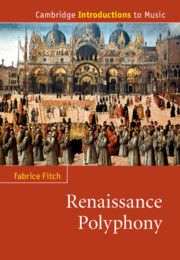Book contents
- Cambridge Introductions to Music
- Cambridge Introductions to Music Renaissance Polyphony
- Copyright page
- Dedication
- Contents
- Illustrations
- Figures
- Tables
- Music examples
- Acknowledgements
- Note on the music examples
- Note on the bibliography
- Abbreviations
- Chapter 1 Introducing Renaissance polyphony
- Chapter 2 Making polyphony: sources and practice
- Chapter 3 Makers of polyphony
- Chapter 4 Pitch: an overview
- Chapter 5 Voice-names, ranges, and functions
- Chapter 6 Mensural notation, duration, and metre
- Chapter 7 Genre, texts, forms
- Chapter 8 ‘Cantus magnus’: music for the Mass
- Chapter 9 ‘Cantus mediocris’: the motet
- Chapter 10 ‘Cantus parvus’: secular music
- Chapter 11 Scoring, texture, scale
- Chapter 12 Understanding musical borrowing
- Chapter 13 Canons, puzzles, games
- Chapter 14 Performance practice: a brief introduction
- Notes
- Glossary
- Bibliography
- Index of compositions
- General index
- Cambridge Introductions to Music
Chapter 12 - Understanding musical borrowing
Published online by Cambridge University Press: 13 August 2020
- Cambridge Introductions to Music
- Cambridge Introductions to Music Renaissance Polyphony
- Copyright page
- Dedication
- Contents
- Illustrations
- Figures
- Tables
- Music examples
- Acknowledgements
- Note on the music examples
- Note on the bibliography
- Abbreviations
- Chapter 1 Introducing Renaissance polyphony
- Chapter 2 Making polyphony: sources and practice
- Chapter 3 Makers of polyphony
- Chapter 4 Pitch: an overview
- Chapter 5 Voice-names, ranges, and functions
- Chapter 6 Mensural notation, duration, and metre
- Chapter 7 Genre, texts, forms
- Chapter 8 ‘Cantus magnus’: music for the Mass
- Chapter 9 ‘Cantus mediocris’: the motet
- Chapter 10 ‘Cantus parvus’: secular music
- Chapter 11 Scoring, texture, scale
- Chapter 12 Understanding musical borrowing
- Chapter 13 Canons, puzzles, games
- Chapter 14 Performance practice: a brief introduction
- Notes
- Glossary
- Bibliography
- Index of compositions
- General index
- Cambridge Introductions to Music
Summary
This chapter examines the use of borrowed material; that is, basing polyphony on existing music, whether plainchant or polyphony previously composed. The techniques described have intentionality in common: cantus firmus treatment of varying degrees of strictness, including paraphrase, ‘imitation’ technique (formerly known as ‘parody’), and more allusive forms. Special consideration is given to the different motivations for the practice (dating back to the origins of polyphony itself), ranging from symbolic or allegorical representation to emulation and competition between composers. Picking up from Chapter 8, the family of ‘L’Homme armé’ Masses offers a case-study of these relationships, but the practice of musical borrowing transcends any single genre, type, or destination. Equally remarkable is the possible range, scale, and scope of allusion, from overt quotation over an entire work to passing reference or evocation of a given technical parameter in ways that may not be directly audible. Finally, different types of borrowing reconfigure the relationship between composer, performer, and audience; these changing dynamics are closely considered.
- Type
- Chapter
- Information
- Renaissance Polyphony , pp. 168 - 196Publisher: Cambridge University PressPrint publication year: 2020

